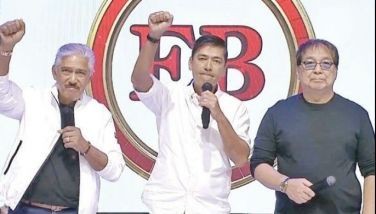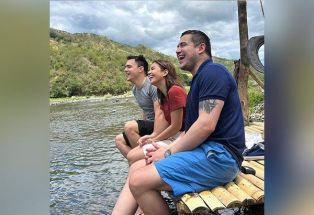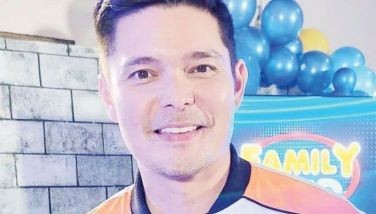I-Witness: Life-changing reporting
MANILA, Philippines - Exposing reality or slices of it is what Sandra Aguinaldo, Kara David and Jay Taruc do as hosts of GMA 7’s I-Witness. Their video documentaries have given the disadvantaged and the disenfranchised the platform to air their concerns that a news coverage cannot tell in one go. Being an eyewitness is a life-changing experience for documentarists, their televiewers and their case studies. This month, I-Witness airs its anniversary special Saturday nights at 10:30 p.m. after Celebrity Bluff. Howie Severino is also a host of the show.
“Yung (mga istorya) na malapit sa sikmura gaya ng gutom, tirahan, walang tsinelas at (mga batang) hindi makapag-aral (Stories that tackle poverty, hunger and homelessness),” replies Sandra when asked of the themes that most of her docus have explored.
As for Jay’s part, he is into urban problems “like congestion, (un)employment and housing (problems),” which can be tied up with Sandra’s. Kara moves away from the city by presenting stories that involve “children and people in remote communities like tribes — yung mga hindi naaabot ng TV, yung mga hindi naaabot ng kuryente (communities which do not have access to TV and with no electricity). Usually, they are those who live in the mountains and faraway islands.”
For the past years, Sandra, Kara and Jay have been telling their stories in a format that their predecessors like Mike Enriquez, Che-che Lazaro, Jessica Soho and Luchi Cruz-Valdez created. It’s the narrator-based documentary.
“There are scenes (which look better) if the narrator is not there,” says Sandra. “As much as possible, I want to take myself out of it. It is also our format to have a narrator in it. It can’t be helped because it is the format.” I-Witness needs hosts so people can associate the program with them.
The advantage of docus with a narrator is the audience can feel and see what the case studies go through. Sandra says, “We write (the script) with insights, we incorporate what we have experienced. One thing about doing I-Witness is to be ready for surprises. We have an outline already, but in the middle of the shoot, the story changes.”
The reason for it could be the consistency of the case study, who, in the process of developing the documentary, compromises his story. The hosts have encountered case studies who expect a fee for doing on-cam interview.
“Ginambala namin sila while we’re there shooting. (And) the least we can do is to provide the equivalent na nawala sa kanila,” says Kara. “I’m so against giving money. I ask them usually what they need. When they say rice, we’ll buy rice or groceries.”
“We made it clear na hindi ito bayad,” adds Sandra.
“You have to explain the context, like our intention is not to bribe,” says Jay. The token is given at the end of the taping. They do this because the case studies may slant the story and tell too much. If the interviewees do not meet the consistency requirement, the hosts move on and work on another topic.
Asked about some people’s opinion that I-Witness also doubles as an advocacy platform, Sandra answers, “There are episodes which are close to your heart. You feel you want to fight for this cause. Sometimes, you make an extra effort to push it forward. There are episodes which have become an advocacy like you end up helping the child. Kasi na feel mo na gusto mong ipaglaban yung sitwasyon niya.”
Since I-Witness is a community-based program, Jay says that the hosts cannot help but find a way to address concerns of the community, like poor services rendered by its health center and lack of physicians. This comes with the territory because Sandra, Kara and Jay stay for a couple of days in the community where their case studies live. They immerse to document the story with objectivity and realism.
“Sinusundan ko ang story,” says Kara. “You need to somehow live it and feel it. You can feel it when you immerse.” While living it, it’s clear to Sandra, Kara and Jay that the story is not about them, it’s about the people; the star of the show is the story and not the storytellers.
“As a program, it has paved the way for other documentary-type shows,” says Jay of I-Witness’ contribution on TV. “When it was started, many would say, ‘Are you serious to discuss child labor for an hour and on the midnight timeslot?’ There were criticisms. Good thing was we had the backing from our pillars who believed in the concept.”
“The word docu(mentary) was not in the mindset of people then,” adds Kara. “When I do I-Witness, I’m not thinking that I’m doing news, that I’m a reporter and I’m doing an extended version of news… With I-Witness, our mission is to give viewers a new pair of eyes to see the world, a new pair of (lenses) to view the world.”
For over a decade, the televiewers have seen issues from a perspective close to home.
(The 15th anniversary special of I-Witness airs all Saturdays of the month.)
- Latest
- Trending



























 Exclusive
Exclusive
